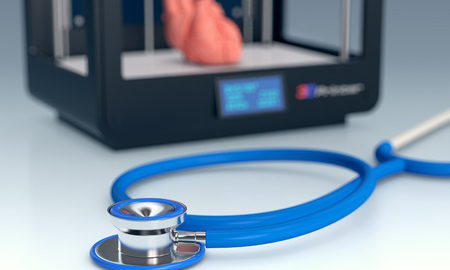Wake Forest Institute Turns 3D Printing Efforts Toward Skin

Wake Forest Institute for Regenerative Medicine (WFIRM) has made major headlines throughout the past year, thanks to their 3-D printing innovations. After breaking new ground by successfully transplanting functional 3-D printed ear, bone, and muscle tissue structures into animals, the researchers and scientists at WFIRM began placing focus in the arena of 3-D printed skin.
WFIRM Partners With AFIRM
The Armed Forces Institute of Regenerative Medicine (AFIRM) is a federally funded project devoted to resolving battle-related injuries with newly developed regenerative medicine technology. WFIRM was invited to lead AFIRM’s second phase, so director Anthony Atala, M.D. led efforts relating to skin regeneration for burn injuries, restoring function to severely traumatized limbs, facial and skull reconstruction using tissue regeneration, treatment to prevent transplant rejection, and reconstruction of the lower abdomen. Given WFIRM’s affinity with 3-D printing, the institute met many of these areas of focus with 3-D printing solutions.
Taking a Closer Look at 3-D Printed Skin
While all of WFIRM’s efforts via 3-D printing are ground-breaking, including the development of bone, nerves, fat, and muscle tissue, WFIRM researchers have given special attention to developing new skin printing technologies that would transform the treatment possibilities for burn victims. In particular, they are working on a technology that would allow new skin to be printed directly into burns and serious injuries.
This treatment format marks a major departure from the traditional method, which involves taking healthy skin from other places on the body and grafting it into the wound. Since extensive burn damages sometimes make grafting impossible, many injured soldiers cannot receive treatment or must wait on a very long donor list before being given the opportunity to heal. WFIRM’s new printer proved capable of printing skin cells directly onto burn wounds, utilizing customized blends of cells based on the type of wound.
How Is It Done?
WFIRM’s ground-breaking printer uses a specialized scanner to evaluate the wound and record its precise depth and size. The depth of the wound plays a particularly important role in treatment, because it determines which types of skin cells were impacted in the injury. All of this scanned data is communicated to the 3-D printer, which then arranges the types of cells to place into each layer of the new printed skin. This system can be utilized even on patients with extreme burns, because it only requires an original skin sample that is one tenth the size of the burn. Just that small fraction of skin cells can generate enough new cells to print viable skin. As the printer produces new skin, it is simply applied directly to the wound for healing to begin.
Moving Forward
This 3-D skin printer, still a prototype, has been used successfully in clinical trials to place new skin on mice and pigs. Now researchers – and the rest of the world – wait anxiously to see how the incredible technology will work on humans. Meanwhile, researchers at Wake Forest are exploring the potential of other materials like stem cells from amniotic fluid and placentas to replace the need for original skin cell samples at all. With the experts at WFIRM leading the way, the possibilities for regenerative medicine healing are truly endless.


